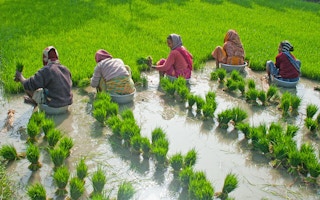Wastewater usage, water-efficient agriculture, knowledge of soil moisture and convergence in agriculture could be possible methods to deal with the twin scourges of climate change and the novel coronavirus disease (Covid-19), according to experts at a recent conference on water.
The conference provided an opportunity to policymakers, academicians, researchers and students to gain expertise from technical experts on matters of water resource engineering and management for water source sustainability by including a combination of theory, conceptual and applied science.
The e-conference on water source sustainability was jointly organised by the Indian Water Resources Society and the department of water resources development and management June 18-20, 2021. The main agenda was the demand and supply of water.
The Indian Space Research Organisation (Isro) has shown that water bodies in India are shrinking in size. “Encroachment is leading to the shrinking of water bodies, which is evident from as many as 87 lakes in Bengaluru that have been encroached upon and have consequently shrunk. How to ensure water supply, its sustainable usage and treatment is the need of the hour,” Chandra Shekhar Jha, scientist and chief general manager, National Remote Sensing Centre, Isro, said.
The conference focussed on various facets of water like management of supply and demand, sustaining water sources in the era of climate change, technological upgradation of traditional methods for water conservation, technological developments for ensuring the sustainability of water sources, treatment technologies and water quality management, people’s active participation in water management and water governance.
Deepankar Saha, former member, Central Ground Water Board explained:
“People’s dependency on groundwater has led to the unplanned and reckless exploitation of ground water sources. There is a need to implement technologies that conserve water and practice sustainable agriculture. Sustainable models should be made on water budgeting, its allocation and management of competitive demand of water in all sectors.”
The conference focused on the analytical and computational aspects of water as well. It was suggested that protocols should be made on the usage and supply of water. India should also have a buffer stock that can be used during emergencies in the future. In a diverse country like India, different models should be made for different regions .
“
From drip irrigation to sprinkler irrigation, convergence is needed in agriculture. Energy and agriculture should be emphasised in any policy or model of water supply and management.
Neelam Patel, senior advisor on agriculture, NITI Aayog
“Substitution of water should be taken into account along with technology, pricing and reuse options. Wastewater should be treated as a resource and not as waste. Once treated and purified, this treated water can be substituted for fresh water. Cohesive decision-making is needed at the central and state level to manage water resources,” Jagdish Prasad Gupta, chief commissioner of state tax, Gujarat explained.
How can we ensure linear water security? Vijay P Singh, a professor at the department of bio and agriculture engineering, A&M University, Texas explained:
“Emphasis should be given to conservation of water and development of alternate sources of water. One can reuse waste water post treatment. An integrated approach is needed to ensure water security by adopting sustainable technologies in mechanical engineering, electrical engineering and chemical engineering.”
India is the country with the highest usage of water in agriculture — 13 per cent — followed by China, US and Russia. Singh also emphasised on making agriculture more water-efficient in India.
How can we ensure water security at a time of climate change? A study undertaken by Stacy L Hucthinson from Kansas State University, US, spoke about the geospatial science of water. It noted:
Countries should shift their focus from global and climate change models to regional models. Climate change has impacted rainfall patterns, thereby leading to variations in soil moisture content. Understanding of soil moisture in varied regions will help in understanding water runoff. The precipitation is usually high in summers and one should focus on acts of downscaling.
“Climate change is not just the issue of greenhouse gas emissions anymore,” says Ed McBean, Canada research chair in water supply security, University of Guelph, Canada. He further explained that water bodies reflect huge amount of reflected radiations which leads to an increase in global temperature, thereby leading to the melting of glaciers and increase in sea levels.
Is the agriculture sector in India leading to water scarcity? Neelam Patel, senior advisor on agriculture, at NITI Aayog shared her views: “From drip irrigation to sprinkler irrigation, convergence is needed in agriculture. Energy and agriculture should be emphasised in any policy or model of water supply and management.”
This story was published with permission from Down To Earth.








